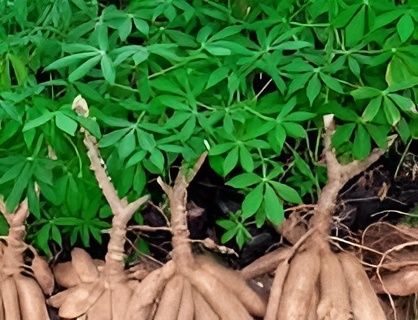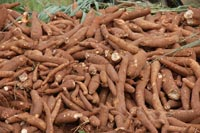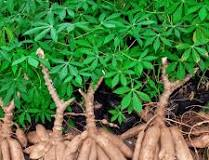Cassava, having the scientific name Manihot esculenta is a tropical and subtropical starchy root vegetable an a staple food in these regions. Also called manioc or tapioca root, it is a good source of carbohydrate and dietary energy. Cassava as a hardy crop grows even in poor soil and withstands drought, making it a vital food source and income earner in many developing countries.
Pictures of uprooted Cassava
Cassava originated from tropical America and was first introduced into the Congo basin of Africa by the Portuguese around year 1558. As at date, Cassava supports the livelihood of over 300 million Africans.
Production
By 2024, Nigeria retained her position as the world’s largest cassava producer with over 59 million tons. This accounted for over 20% of global cassava production. While Nigeria is a major producer, the yield per hectare is relatively low – about 8 tons per hectare, relative to other producing countries like Brazil and China with 35tonnes per hectare.
On regional scale, Benue and Kogi States dominate production in the North-Central region, Enugu and Imo states dominate in the South-Eastern region, Ogun, Ondo and Oyo states dominate in the South-Western region while Rivers, Cross River, Akwa Ibom and Delta States dominate in the South-Southern region of Nigeria culminating in the world record.
The industry is hampered by challenges like low productivity, poor access to fund and inconsistent government policies. However, there is significant potential for growth and development, including opportunities for industrialization and product diversification to maintain Cassava’s contribution to food security and economic development.
Composition of cassava
According to international Institute for Tropical Agriculture (IITA), the nutritional composition of cassava differs according to variety, age at harvest, soil condition, climate, and other environmental factors during cultivation. The above factors also affect the cyanide level of cassava plant which varies from 75ppm to 350 ppm, even up to 1000ppm in some cases.
Nevertheless, cassava is a good source of carbohydrate and food derived energy. It contains calcium, potassium, folate, vitamin B, Vitamin C and other essential minerals. It is also rich in dietary fibre vital for digestive health and resistant starch which is beneficial for gut health. Its raw form contains cyanogenic glycosides, a precursor for cassava hydrogen cyanide. But, Cassava processing from peeling, soaking, grating, fermentation, sieving and roasting all culminate in reduction of the cyanide content by about 95% which either leaches out with water, get metabolised by the enzyme, or vaporised with drying, being a weak acid that partially dissociates in aqueous solutions.
Cyanide degradation in cassava processing
Enzymes degrade cyanides through; hydrolytic, oxidative, reductive, and substitution/transfer pathways.
- Hydrolytic pathways utilize enzymes like cyanide hydratase, nitrile hydratase, and cyanidase,
- Oxidative pathways employ enzymes as cyanide monooxygenase, cyanase, and cyanide dioxygenase.
- Reductive pathways utilize nitrogenase, and substitution/transfer pathways involve enzymes like β-cyanoalanine synthase and nitrile hydratase/nitrilase
The enzymatic cyanide degradation process takes the following course:
HCN + 2H20 è HCOO- + NH4+ (1)
HCN + H20 è HCOONH2 è HCOO- + NH4+
These experiment derived equations strongly indicate that the biocatalyst decomposes cyanide to ammonia and formate in a one-step reaction (Eq.1), while Formamide is the main product of the enzymatic decomposition by fungi (Eq. 2), (S. Basheer et’al., 1991).
The result is a cassava product relatively free of cyanide with values far below the safe level of 10mg/kg established as standard by WHO.
Role of each enzyme
- Cyanase contributes to the oxidative degradation of cyanide.
- Cyanide Monooxygenase (CNO) catalyses the oxidation of cyanide.
- Cyanide Dioxygenase catalyzes the oxidation of cyanide to a more stable form.
- Cyanide Hydratase converts cyanide to formamide which is further metabolized.
- Nitrogenase, reductively degrades cyanide to ammonia and other reduced nitrogen compounds.
- Cyanidase hydrolyses cyanide to simpler compounds, contributing to the detoxification process.
- Nitrile Hydratase/Nitrilase along with CAS, completes the conversion of cyanide to amino acids.
- Nitrile Hydratase along with Nitrilase transform cyanides into amino acids, such as asparagine or aspartate.
- β-Cyanoalanine Synthase (CAS) initiates the substitution/transfer steps in the cyanide degradation pathway.
Uses of cassava
Aside being a source of staple food, cassava is very versatile with its derivatives useful or applicable in many ways:
- Foods (Garri, Flour etc)
- Confectioneries,
- Sweeteners (Sorbitol),
- Glues,
- Biodegradable products,
- Monosodium glutamate,
- Drugs (Pharmaceuticals),
- Cassava chips & pellets,
- Animal feeds and
- Ethanol production.
Market for Cassava
The global cassava market size as of 2024 was valued at $175.9 billion, projected to be $254 billion by 2031 with a compound annual growth rate (CAGR) of 5.40%. This growth is driven by increased demand for cassava in various applications like food, pharmaceuticals, and animal feed. Nigeria has the potential to generate $427.3 million from domestic value-addition and $2.98 billion from agricultural exports. The main export destinations for Nigeria’s Cassava are: United Kingdom, Spain, Canada, China and Niger.
Despite Nigeria being the highest producer of cassava in the world, she recorded a low total export value ($1.25million) compared with other leading producers like Thailand ($1.19billion). This is sequel to poor yield per hectare, poor technological input, low rate of value addition, poor socio-economic situation leading to more consumption above exportation. However, Cassava production in Nigeria shows potential for profitability, with an average economic efficiency of 61–65% (Akpan et’ al., 2013, Ettah & Kuye, 2017). Basically, production and sale of Garri (a widely consumed staple food in Nigeria) contributes significantly to the cash income of many local farmers (Food and Agriculture Organisation). The low export value of cassava products is a potential invitation for massive investment and growth in the cassava value chain and export sector.
Conclusion
There is a huge investment gap yawning for attention in the cassava value chain. The notorious hydrogen cyanide associated with cassava is usually hydrolysed or metabolised by enzymes within the production process to a harmless concentration in the products. Cassava contains nutrients, vitamins and minerals beside the carbohydrate or starch it is known for. Embrace cassava value chain, the new tropical gold mine in Nigeria.
Dr. Ekpobari NEEBEE
Managing Director, Nebex Foods Limited, Nigeria.
+2348035499772 (Phone/WhatsApp), E-mail: nebexfoods@yahoo.com.




